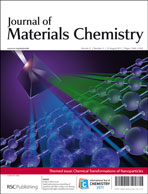Converting AgCl nanocubes to sunlight-driven plasmonic AgCl : Ag nanophotocatalyst with high activity and durability†
Abstract
Uniform AgCl nanocubes with an average edge length of 85 nm have been prepared by a facile reverse micelle method. Partially reducing the as-produced AgCl nanocubes enables us to achieve a class of sunlight-driven plasmonic AgCl : Ag nanophotocatalysts. The

- This article is part of the themed collection: Chemical Transformations of Nanoparticles

 Please wait while we load your content...
Please wait while we load your content...